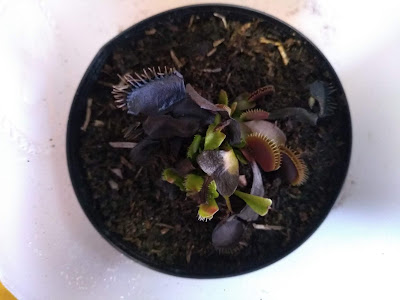Recently I obtained a tiny plant of
Allium nutans. These plants have several common names including "blue
chives", "Siberian chives", "Mongolian blue chives", etc.
Apparently these perennial onions grow wild in Siberia, Mongolia, parts of China, and several surrounding places where they are collected and used as food. They are said to be extremely hardy and easy to grow. For some reason Mongolian blue chives are rare in Australia and very few people have even heard of them.
Apparently these perennial onions grow wild in Siberia, Mongolia, parts of China, and several surrounding places where they are collected and used as food. They are said to be extremely hardy and easy to grow. For some reason Mongolian blue chives are rare in Australia and very few people have even heard of them.
Blue chives are an edible plant that have flat leaves which look similar to garlic chives (Allium tuberosum) except blue chives are more of a blue green. This perennial onion tastes much like regular onion
chives (Allium schoenoprasum) and can be used as a substitute
for onion chives. The flowers are meant to be edible but I haven’t tried
them so can’t comment.
Various
different forms of blue chives exist, some are meant to be better than
others, the one I have is an unnamed variety that seems pretty good so
far. I don't think any of the named forms are grown in Australia, finding this species at all was very difficult as it is so rarely grown here.
Several interspecific hybrids with Allium nutans also exist, some have large flat leaves and others having interesting flowers, I am not sure if any hybrids are in Australia at the moment.
Several interspecific hybrids with Allium nutans also exist, some have large flat leaves and others having interesting flowers, I am not sure if any hybrids are in Australia at the moment.
Blue chives
divide into several plants throughout their growing season, these can
be separated and planted out or allowed to naturalise and form a clump.
Mine sare yet to flower, the flowers I have seen on the internet
are very pretty and are said to attract insect pollinators.
Apparently blue chives set viable seed easily and I am told they are simple to grow from seed. Nowhere seems to sell seed but I am not sure of the reason behind this. Once my plants flower I plan to grow out as many seeds as it produces so I can build up its numbers.
Apparently blue chives set viable seed easily and I am told they are simple to grow from seed. Nowhere seems to sell seed but I am not sure of the reason behind this. Once my plants flower I plan to grow out as many seeds as it produces so I can build up its numbers.
 |
| Blue chives |
While
several interspecific hybrids currently exist, I have no idea how
difficult blue chives would be to cross with other allium species. I
would love to try hybridising this in the future, but may never get
around
to it for a number of reasons.
Much like
all my perennial onions, I grow blue chives organically and don’t have
any issues with pests or diseases. I imagine there are probably a few
things that could kill them but I am lucky enough that they
are not in my garden.
Like most other vegetables I grow them in full sun, and I water them often if I can. I ran out of water over summer and didn't water them very much. So far
they have coped really well with frosts as well as summer heat.
If you want
to grow a unique perennial vegetable that looks like garlic chives,
tastes like onion chives, and no one else is growing, then blue chives
are for you.
Mine have divided a little since the above pictures, but I still don't have very many of them. When I have built up their numbers and have a few plants to spare, or if my plants produce seed and I have some extra, I will list them on my for sale page.
Mine have divided a little since the above pictures, but I still don't have very many of them. When I have built up their numbers and have a few plants to spare, or if my plants produce seed and I have some extra, I will list them on my for sale page.







































